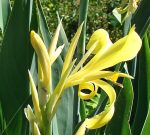 Canna glauca is a herbaceous perennial in the Cannaceae family that is most closely related to ginger, bird of paradise, and banana. It is native to the West indies and tropical America including parts of the US where it grows in the margins of marshes, swamps, and ponds. Plants grow 4-6′ tall from a rhizomatous rootstock and have unbranched fleshy stems sheathed by large bluish green leaves with pointed tips and white margins. The large slender flowers are pale yellow and appear in summer. C. glauca is a good choice for a water garden, container, or back of the border but will have to be lifted and stored in cold climates. The roots can be eaten like arrowroot. The genus name, Canna, comes from the Greek word kanna meaning reed. The specific epithet, glauca, comes from the Greek word glaukos meaning grayish blue and refers to the color of the leaves.
Canna glauca is a herbaceous perennial in the Cannaceae family that is most closely related to ginger, bird of paradise, and banana. It is native to the West indies and tropical America including parts of the US where it grows in the margins of marshes, swamps, and ponds. Plants grow 4-6′ tall from a rhizomatous rootstock and have unbranched fleshy stems sheathed by large bluish green leaves with pointed tips and white margins. The large slender flowers are pale yellow and appear in summer. C. glauca is a good choice for a water garden, container, or back of the border but will have to be lifted and stored in cold climates. The roots can be eaten like arrowroot. The genus name, Canna, comes from the Greek word kanna meaning reed. The specific epithet, glauca, comes from the Greek word glaukos meaning grayish blue and refers to the color of the leaves.
Type: Herbaceous perennial
Bloom: Large slender pale yellow flowers in summer
Size: 4-6′ H x 3″ W
Light: Full sun
Soil:Fertile, moist, well-drained
Hardiness: Zones 8-10
Care: Deadhead, fertilize
Pests and Diseases: Slugs
Propagation: Seed, division at planting time
Companion Plants: Gunnera, elephant ear, hibiscus
7-10